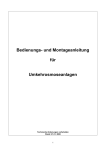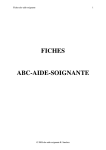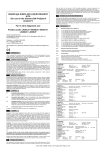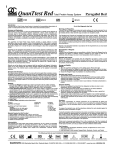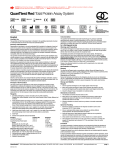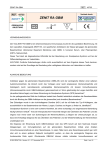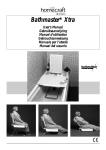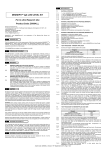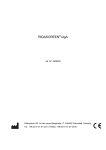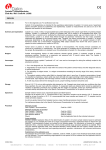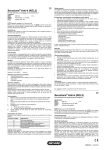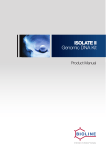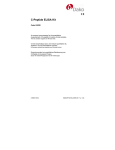Download Human IgA2 Kit for use on SPAPLUS For in
Transcript
6 Human IgA2 Kit for use on SPAPLUS For in-vitro diagnostic use Product Code: LK088.S Product manufactured by: The Binding Site Group Ltd., PO Box 11712, Birmingham B14 4ZB, UK. www.bindingsite.co.uk Telephone: +44 (0)121 436 1000 Fax: +44 (0)121 430 7061 E-mail: [email protected] FDA (USA) Information: Analyte Name: Immunoglobulins A subclasses Complexity Category: Moderate 1 INTENDED USE This kit is intended for quantifying human IgA subclass 2 (IgA2) in serum using the Binding Site SPAPLUS turbidimetric analyser. Measurement of this immunoglobulin aids in the diagnosis of abnormal protein metabolism and the body’s lack of ability to resist infectious agents. The test result is to be used in conjunction with other clinical and laboratory findings. 2 SUMMARY AND EXPLANATION Two classes of IgA have been identified in humans: IgA1, which accounts for 80-90% of total serum IgA, and IgA2 which is the major subclass in secretions such as milk. The two subclasses appear to be regulated independently. Antigenic sites on the IgA subclasses are responsible for the anaphylactic transfusion reactions experienced by some patients totally deficient in either IgA1 or IgA2. After repeated transfusion such patients may produce antibodies to these antigens. IgA subclasses are of further importance in that certain pathogenic microorganisms, including Haemophilus influenzae, are capable of enzymic cleavage of IgA1, leading to partial inactivation of this subclass. Recurrent sinopulmonary infections may therefore be related to deficiency of IgA2 which is resistant to these organisms (refs 1, 2 & 3). 3 PRINCIPLE Evaluating the concentration of a soluble antigen by turbidimetry involves the addition of the test sample to a solution containing the appropriate antibody in a reaction vessel or cuvette. A beam of light is passed through the cuvette and, as the antigen-antibody reaction proceeds, the light passing through the cuvette is scattered increasingly as insoluble immune complexes are formed. Light scatter is monitored by measuring the decrease in intensity of the incident beam of light. The antibody in the cuvette is in excess so the amount of immune complex formed is proportional to the antigen concentration. A series of calibrators of known antigen concentration are assayed initially to produce a calibration curve of measured light scatter versus antigen concentration. Samples of unknown antigen concentration can then be assayed and the results read from the calibration curve. The sensitivity of turbidimetric assays can be increased by the use of particle enhancement (ref. 4). This entails linking the antibody to a suitably sized particle that increases the relative light-scattering signal of the antigen-antibody reaction. 4 4.1 4.2 4.3 7 Human IgA2 Latex Reagent: Consisting of monospecific sheep antibody coated onto polystyrene latex and is supplied in stabilised liquid form. Preservatives: 0.099% sodium azide, 0.1% E-amino-n-caproic acid (EACA), 0.01% Benzamidine, 0.05% ProClin™ 300 and 1% Protease Inhibitor Cocktail 1 (Calbiochem Catalogue No. 539131). Calibrator and Controls: These consist of pooled human serum and are supplied in stabilised liquid form. They contain 0.099% sodium azide, 0.1% EACA and 0.01% benzamidine as preservatives. The concentration of IgA2 given on the quality control certificate has been obtained by comparison with the CRM470 international reference material. Reaction Buffer: Containing 0.099% sodium azide as a preservative. SPECIMEN COLLECTION AND PREPARATION Use fresh or deep frozen serum samples. Blood samples should be collected by venepuncture, allowed to clot naturally and the serum separated as soon as possible to prevent haemolysis. The serum may be stored at 2-8°C for up to 48 hours prior to assay, or for prolonged storage kept at -20°C or below. Repeated freezing and thawing should be avoided. Microbially contaminated, haemolysed and lipaemic serum and samples containing particulate matter should not be used. 8 METHODOLOGY 8.1 Materials provided 8.1.1 8.1.2 8.1.3 8.1.4 8.1.5 1 1 2 2 1 8.2 Materials required but not provided 8.2.1 8.2.4 Equipment for collection and preparation of test samples e.g. sample tubes, centrifuge etc. A fully operational and equipped SPAPLUS analyser. Current analyser operating instructions: SPAPLUS Reference Guide, Insert Code FIN012. Sample Diluent (99: Dil 1) Product Code: SN080.S 8.3 Reagent preparation 8.2.2 8.2.3 x 50 Tests Human IgA2 Latex SPAPLUS x Human IgA2 SPAPLUS Calibrator set 1-6 (6 x 1.0mL) x 1.2mL Human IgA Subclass SPAPLUS High Control x 1.2mL Human IgA Subclass SPAPLUS Low Control x 50 Tests IgA2 Reaction Buffer SPAPLUS Before loading, gently mix by inversion ensuring no foam or bubbles are generated or remain on the surface as these may interfere with reagent aspiration. 8.4 Test procedure The user should be familiar with the operation of the SPA PLUS analyser before attempting to carry out the test procedures. The analyser should be prepared for use according to the manufacturer's instructions and the assay protocol entered as described below. For full details of analyser operation refer to the SPA PLUS Reference Guide, (FIN012) supplied with the analyser. 8.4.1 Test parameters Assay parameters are entered into item number 12. Item Name 12 IgA2 DATA INFORMATION Units Decimals mg/L 1 ANALYSIS Type End ▼ Main W.Length 1 Sub W.Length Method CORR. Y= REAGENTS STORAGE AND STABILITY The unopened kit should be stored at 2-8°C and can be used until the expiry date shown on the kit box label. DO NOT FREEZE. The Human IgA2 Latex Reagent, Reaction Buffer, Calibrators and Controls may be stored for up to three months after opening, provided that they are capped to avoid evaporation and kept at 2-8°C in a refrigerator. The Human IgA2 Latex Reagent and Reaction Buffer may be stored at 8-12°C uncapped, on the SPAPLUS analyser for up to 30 days, provided that the main power switch (located at the rear of the left hand panel) is left switched on. 600 ▼ ▼ SLOPE INTER 1 X+ 0 Page : 1 Item Name 12 Print Hard Copy IgA2 ASPIRATION KIND ○ Single ● Double VOLUME SAMPLE 3 REAGENT1 VOL 145 µL REAGENT2 VOL 80 Third mix ● OFF ○ ON R1 Blank ● Water – Blank 5 CAUTION This product contains sodium azide and ProClin 300 and must be handled with caution. Do not ingest or allow contact with the skin (particularly broken skin or open wounds) or mucous membranes. If contact does occur wash with a large volume of water and seek medical advice. Explosive metal azides may be formed on prolonged contact of sodium azide with lead and copper plumbing; on disposal of reagent, flush with a large volume of water to prevent azide build up. This product should only be used by suitably trained personnel for the purposes stated in the Intended Use. Strict adherence to these instructions is essential at all times. Results are likely to be invalid if parameters other than those stated in these instructions are used. Reagents from different batch numbers of kits are NOT interchangeable. If large numbers of tests are performed care should be taken to ensure that all the reagents are from the same batch. 0 LEVEL SPAN 1 SPAN 3.0 Page : 2 Print Hard Copy *Automatically calculated MALE HIGH ][ ] ][ ] ][ ] ][ ] ][ ] ][ ] Save LOW Serum [ Urine [ Plasma [ CSF [ Dialysis [ Other [ Next Page DATA PROCESS READ START END MAIN 53 54 SUB 35 36 FEMALE LOW HIGH [ ] [ [ ] [ [ ] [ [ ] [ [ ] [ [ ] [ Return ] ] ] ] ] ] ABSORBANCE LIMIT LOW -3.0 HIGH 3.0 FACTOR Blank correction 1 ENDPOINT LIMIT 2.0 LINEAR CHECK (%) 0 Reaction Check ○ ON ● OFF CHECK POINT LOW -3 HIGH 3 START FIRST [ ] [ SECOND [ ] [ THIRD [ ] [ Prev Page END LIMIT (%) ] ] [ ] ○ Low ] [ ] ○ Low Next Page Save IgA2 Auto Rerun SW ● On ○ Off Auto Rerun Range (Result) ● On ○ Off ○ On ● Off Lower Higher Serum Cal 1 # Cal 6 # Urine Plasma CSF Dialysis Other Bottle Size (ml) 24 Items Reagent1 60 Reagent2 R1 7.75 Reagent2 R2 4.5 Page : 3 NORMAL RANGE ○100: Dil 2 ▼ ▼ ▼ PROZONE CHECK MONITOR Item Name 12 4 # 5 # 6 # DILUTION Diluent ● 99: Dil 1 Pre Dilution Rate 10 Auto Rerun Dilution Rate High Auto Rerun Dilution Rate Low ProClin™ is a trademark of Rohm and Haas Corp., Philadelphia, PA. All donors of human serum supplied in this kit have been serum tested and found negative for hepatitis B surface antigen (HBsAg) and antibodies to human immunodeficiency virus (HIV1 and HIV2) and hepatitis C virus. The assays used were either approved by the FDA (USA) or cleared for in vitro diagnostic use in the EU (Directive 98/79/EC, Annex II); however, these tests cannot guarantee the absence of infective agents. Proper handling and disposal methods should be established as for all potentially infective material, including (but not limited to) users wearing suitable gloves, protective equipment and clothing at all times. Only personnel fully trained in such methods should be permitted to perform these procedures. CALIBRATION Type Logit 2 ▼ Standard 1 # 2 # 3 # Auto Rerun Condition (Absorbance) Absorbance Range Lower ● On Higher ○ On Prozone Range ○ On ○ Off ● Off ● Off 36 Items Reagent1 Reagent2 R1 Reagent2 R2 Print Insert Code: SIN179, Version: 18th August 2010, Page 1 of 8 Prev Page Save Return ● High ● High Return NB. The calibrator (Standard #) values to be entered on Page: 1 are found on the quality control certificate and should be entered in ascending order, i.e. lowest value first. IMPORTANT: the analyser will automatically calculate and enter the correct measuring ranges on Item pages 3 and 4 providing the ENTER button is pressed after typing the value for calibrator 6 on Page: 1. You may view Item parameter page 4 to ensure correct value entry. 1. 8.4.2 3. Control volumes For each control: transfer 120μL plus 30μL for each assay that requires the control, into a sample cup and place on the rack. E.g. if both subclasses and IgA require control measurements, then 120μL + 90μL= 210μL will be required. NB: This can only be done if the control batches supplied in the IgA and IgA subclass kits are the same. If different control batches are in use, extra controls should be set up. 8.5 13 2. 4. BIBLIOGRAPHY Protein Reference Unit Handbook of Clinical Immunochemistry (1990) Ed. A. Milford Ward, Publ. PRU Publications, Sheffield, 133-134. Mestecky, J. et al (1989). Comparative studies of the biological properties of human IgA subclasses. Protides of the Biol. Fluids 36, 179-182. Conley, M.E. et al (1983). Serum levels of IgA1 and IgA2 in children and in patients with IgA deficiency. Mol. Immunol. 20, 977-981. Tang LX, Showell P, Carr-Smith HD, Mead GP, Drew R and Bradwell AR (2000). Evaluation of F (ab’) 2-based latex-enhanced nephelometric reagents for free immunoglobulin light chains on the Behring Nephelometer™ II. Clin. Chem 46:6, Suppl. 2000, 705, pA181. Measuring range The approximate measuring range of the IgA2 assay when using the standard 1/10 sample dilution is 50-1250 mg/L. 9 QUALITY CONTROL The controls provided should be included in all assay runs. The IgA2 concentration is stated on the accompanying QC certificate (SIN179.QC). Sample results obtained should only be accepted if the control results are within ±15% of the concentration(s) stated. 10 10.1 10.2 10.3 10.4 10.5 11 LIMITATIONS Turbidimetric assays are not suitable for measurement of highly lipaemic or haemolysed samples or samples containing high levels of circulating immune complexes (CICs) due to the unpredictable degree of non-specific scatter these sample types may generate. Unexpected results should be confirmed using an alternative assay method. This assay has not been validated using paediatric samples. Should a control measurement be out of range when assayed with a stored curve the assay must be recalibrated. If on recalibration the control values measured with the new curve are still out of range, the instrument and the assay parameters should be checked before repeating the assay. If problems persist, refer to supplier. Diagnosis cannot be made and treatment must not be given on the basis of IgA2 measurements alone. Clinical history and other laboratory findings must be taken into account. Variation in reagent temperature may affect results. Ensure that reagents are transferred directly from the refrigerator to the refrigerated reagent compartment of the analyser – do not allow to warm to room temperature. EXPECTED VALUES The ranges provided have been obtained from a limited number of samples and are intended for guidance purposes only. Wherever possible it is strongly recommended that local ranges are generated. Adult serum ranges These ranges were obtained using this kit, by measuring the IgA2 concentration of sera taken from healthy adult UK blood donors. The reference interval was calculated using nonparametric statistics and represents the central 95% of the population. Number (n) 120 IgA2 12 12.1 Mean (mg/L) 392.5 Median (mg/L) 95 Percentile Range (mg/L) 321.9 68.9 – 1142.5 PERFORMANCE CHARACTERISTICS Precision A study was performed following CLSI Evaluation of Precision Performance of Clinical Quantitative Measurement Methods; Approved Guideline (CLSI Document EP5-A2). The study was performed over 21 working days, with two runs per day. One user assessed three different samples using three different reagent lots on three analysers. Serum 1 Serum 2 Serum 3 12.2 Mean (mg/L) 1121.47 684.56 79.93 IgA2 Precision summary Within run Between run SD CV % SD CV % 31.14 2.8 16.43 1.5 15.46 2.3 10.92 1.6 3.37 4.2 3.01 3.8 Between day SD CV % 68.36 6.1 25.95 3.8 6.00 7.5 Total SD CV % 76.89 6.9 32.11 4.7 7.51 9.4 Comparison A correlation study was performed on 89 samples (26 normal serum and 64 clinical serum) using this kit on a SPAPLUS and an alternative commercially available IgA2 assay. The study demonstrated excellent agreement with the following Passing Bablok plot: y = 0.99x – 1.16 (mg/L) (y = SPAPLUS IgA2; x = alternative assay) correlation coefficient r = 0.994 (calculated by linear regression) 12.3 Limit of Blank and Limit of Detection Based on CLSI document EP17-A - Protocols for Determination of Limits of Detection and Limits Quantitation; Approved Guideline the limit of detection represents the lowest measurable analyte level that can be distinguished from zero. This has been estimated at 1.87 mg/L (n = 60). The limit of quantitation for this assay is defined as the lowest point of the calibration curve i.e. 4.9mg/L based upon measuring neat sample. 12.4 Linearity A linearity study was performed based on NCCLS Evaluation of the Linearity of Quantitative Measurement Procedures (NCCLS Document EP6-A). One user assessed the linearity of a pool of high samples using one lot of reagent on one analyser. This gave a regression plot of y = 1.023x + 1.296 (y = measured IgA2 concentration, x = theoretical concentration) over the range of 73.77- 1250mg/L using the analyser’s 1/10 sample dilutions. 12.5 Interference No significant assay interference by 1530 formazine turbidity units (FTU) of chyle, 200mg/L bilirubin, 4.83g/L haemoglobin has been demonstrated at the minimum sample dilution (1/1). Bilirubin Hb Chyle 19.2 19.4 19.7 Mean IgA2 (mg/L) -0.93% 0.7% 1.0% % interference 12.6 Antigen excess No antigen excess was observed to a level of five times the top point of the assay; approximately 6.55g/L. Insert Code: SIN179, Version: 18th August 2010, Page 2 of 8 6 Human IgA2 Kit zur Verwendung auf dem SPAPLUS Nur zur in-vitro Diagnostik Bestell-Nr.: LK088.S Hergestellt von: The Binding Site Group Ltd, PO Box 11712, Birmingham, B14 4ZB, UK. www.bindingsite.co .uk Vertrieb in Deutschland und Österreich durch: The Binding Site GmbH, Robert-Bosch-Straße 2A D-68723 Schwetzingen, Deutschland Telefon: +49 (0) 6202 92 62 0 Fax: +49 (0) 6202 92 62 222 e-mail: [email protected] 1 2 VERWENDUNGSZWECK EINLEITUNG Beim Menschen sind zwei IgA Subklassen bekannt. IgA1, das ca. 80–90% des gesamten Serum-IgA ausmacht, und IgA2, welches hauptsächlich in Körpersekreten, wie z.B. Muttermilch gefunden wird. Man vermutet, dass die beiden IgA Subklassen unabhängig voneinander reguliert werden. Auf den IgA-Subklassen-Molekülen gibt es antigene Bereiche, die bei Patienten mit totaler IgA1– oder IgA2-Defizienz zu anaphylaktischen Transfusionsreaktionen führen. Nach wiederholter Transfusion können solche Patienten Antikörper gegen diese antigenen Bereiche produzieren. Die Wichtigkeit der IgA Subklassen zeigt sich auch in folgenden Beispiel: einige pathogene Mikroorganismen, wie z.B. Haemophilus influenzae, sind in der Lage IgA1 zu spalten. Dies führt zu einer teilweisen Inaktivierung dieser Subklasse. Wiederholte Infektionen im Nasen-Rachen-Raum können daher auf eine IgA2-Defizienz hindeuten, denn diese Subklasse ist gegen diesen Organismus resistent. (Ref. 1,2 & 3) 3 4 PROBENENTNHAME UND-VORBEREITUNG Immer frisches oder tiefgefrorenes Serum verwenden. Blutproben über Venenpunktur sammeln und auf natürliche Weise gerinnen lassen. Serum so schnell wie möglich vom Gerinnsel trennen um eine Hämolyse zu vermeiden. Die Proben können bei 2-8°C bis zu 48 Stunden vor dem Test gelagert werden. Für eine längere Lagerung wird empfohlen die Proben unverdünnt bei mindestens -20°C einzufrieren. Wiederholtes Einfrieren und Auftauen vermeiden. Keine mikrobiell oder mit Partikeln verunreinigte Proben, oder hämolytische oder lipämische Seren verwenden. TESTDURCHFÜHRUNG 8.1 Gelieferte Materialien 8.1.1 8.1.2 8.1.3 8.1.4 8.1.5 1 x 50 Tests Human IgA2 Latex SPAPLUS (Human IgA2 Antiserum für den SPAPLUS) 1 x Human IgA2 SPAPLUS Calibrator set 1-6 (6 x 1.0mL) (Kalibrator-Set für IgA2) 2 x 1,2mL Human IgA Subclass SPAPLUS High Control (IgA2 Kontrolle ‘High-Level’) 2 x 1,2mL Human IgA Subclass SPAPLUS Low Control (IgA2 Kontrolle ‘Low-Level’) 1 x 50 Tests IgA2 Reaction Buffer SPAPLUS (IgA2 Reaktionspuffer). 8.2 Benötigte, nicht im Kit enthaltene Materialien 8.2.1 8.2.2 8.2.3 8.2.4 Laborausstattung zum Sammeln und Vorbereiten der Proben (Probenröhrchen, Zentrifugen etc.) Einen vollausgestatteten und funktionsfährigen SPAPLUS Analyser. Aktuelle Geräte-Bedienungsanleitung: SPAPLUS Bedienungsanleitung (FIN012). Probendiluens 99: Dil 1 Bestell-Nr.: SN080.S 8.3 Vorbereitung der Reagenzien Die Reagenzien vorsichtig schütteln bevor sie ins Gerät gestellt werden. Dabei Schaumund Blasenbildung vermeiden, da dies Störungen beim Pipettieren verursachen kann. 8.4 Testdurchführung Der Anwender sollte mit dem SPAPLUS vertraut sein, bevor der Test durchgeführt wird. Das Gerät, wie im Handbuch des Herstellers beschrieben, vorbereiten. Die Tesparameter werden wie nachfolgend aufgeführt eingegeben: Eine ausführliche Beschreibung entnehmen Sie der SPAPLUS Bedienungsanleitung (FIN012), die mit dem Gerät geliefert wird. 8.4.1 TESTPRINZIP Die turbidimetrische Bestimmung der Konzentration von löslichen Antigenen beruht auf der Reaktion zwischen einem Antigen und einem spezifischen Antiserum in einem Reaktionsgefäß oder Küvette, wodurch unlösliche Immunkomplexe gebildet werden. Wird Licht durch die Küvette gestrahlt, wird das Licht mit zunehmender Konzentration an Immunkomplexen gestreut. Die Lichtstreuung wird bestimmt, indem die Intensitätsabnahme des einfallenden Lichtstrahls gemessen wird. Da der Antikörper sich im Überschuss in der Küvette befindet, ist die Menge an Immunkomplexen direkt proportional zur Antigenkonzentration. Eine Reihe von Kalibratoren mit bekannter Antigenkonzentration werden gemessen und anhand der Messsignale wird eine Kalibrationskurve berechnet. Die Antigenkonzentration von unbekannten Proben wird automatisch nach der Messung direkt an Hand der im Gerät gespeicherten Kalibrationskurve berechnet. Die Empfindlichkeit der turbidimetrischen Tests kann durch eine Partikelverstärkung erhöht werden (Ref.4). Dazu wird der Antikörper an einen Partikel geeigneter Größe gekoppelt und dadurch wird das relative Streulichtsignal während der Antigen-Antikörper-Reaktion verstärkt. 4.1 7 8 Zur quantitativen Bestimmung der Human IgA Subklasse 2 (IgA 2) im Serum unter Verwendung des Binding Site SPAPLUS-Analysers. Die Bestimmung dieses Immunglobulins hilft bei der Diagnose eines abnormalen Proteinmetabolismus und das Unvermögen des Körpers auf infektiöse Erreger zu reagieren. Die Testergebnisse sollten immer im Zusammenhang mit anderen klinischen Befunden oder Laborbefunden interpretiert werden. LAGERUNG UND STABILITÄT Die ungeöffneten Kits sind bei 2-8°C bis zum auf dem Außenetikett angegebenen Verfallsdatum haltbar. NICHT EINFRIEREN! Nach dem Öffnen sind das Human IgA2Latex-Reagenz, der Reaktionspuffer, die Kalibratoren und Kontrollen für 3 Monate im Kühlschrank bei 2-8°C stabil,, vorausgesetzt die Gefäße werden nach jeweiligem Gebrauch wieder mit Deckel verschlossen um Verdunstung oder Verunreinigung zu vermeiden. Das Human IgA2- Latex-Reagenz und der Reaktionspuffer können auch ohne Deckel bei 8-12°C bis zu 30 Tage im SPAPLUS-Analyser gelagert werden, solange die Kühlung angeschaltet ist. (Hauptsromschalter bleibt immer auf Position an. REAGENZIEN Test Parameter Die Testparameter werden unter Item Nummer 12 eingeben. Item Name 12 IgA2 DATA INFORMATION Units Decimals mg/L 1 ANALYSIS Type End ▼ Main W.Length 1 Sub W.Length Method CORR. Y= SLOPE INTER 1 X+ 0 Page : 1 Human IgA2 Latex-Reagenz: Besteht aus monospezifischen Schaf-Antikörpern, die an Polysteren-Latexpartikel gekoppelt wurden. Liegt als stabilisierte Flüssigkeit vor. Enthaltene Konservierungsmittel: 0,099% Natriumazid, 0,1% E-amino-N-capronsäure (EACA), 0,01% Benzamidin 0,05% ProClin™* 300 und 1% Protease Inhibitor Cocktail 1 (Calbiochem Catalogue No. 539131). 4.2 Kalibratoren und Kontrollen: Sie werden aus normalem, gepooltem Humanserum hergestellt und liegen als stabilisierte Flüssigkeiten vor. Enthaltene Konservierungsmittel: 0,099% Natriumazid, 0,1% EACA und 0,01% Benzamidin. Die auf dem QC-Zertifikat angegebene IgA2-Konzentration wurde durch Vergleich mit dem Internationalen Referenzmaterial CRM470 erhalten. 4.3 Reaktionspuffer: Enthaltene Konservierungsmittel: 0,099% Natriumazid. 600 ▼ ▼ Item Name 12 Print Hard Copy IgA2 ASPIRATION KIND ○ Single ● Double VOLUME SAMPLE 3 REAGENT1 VOL 145 µL REAGENT2 VOL 80 Third mix ● OFF ○ ON R1 Blank ● Water – Blank 5 WARNUNGEN UND VORSICHTSMAßNAHMEN Achtung: Dieses Produkt enthält Natriumazid und ProClin 300 und muss mit den entsprechenden Vorsichtsmaßnahmen behandelt werden. Verschlucken sowie Kontakt mit Haut (v.a. bei Verletzungen) oder Schleimhäuten vermeiden. Nach Kontakt Hautstelle mit viel Wasser abspülen und ärztlichen Rat einholen. Natriumazid kann mit Blei- oder Kupferrohren explosive Metallazide bilden. Nach der Entsorgung mit ausreichender Menge Wasser, nachspülen um Azidablagerungen zu vermeiden. Dieser Test sollte nur für den angegebenen Verwendungszweck von entsprechend geschultem Laborpersonal durchgeführt werden. Die Einhaltung der Arbeitsanleitung bei allen Arbeitsschritten ist dringend notwendig. Bei Verwendung von abgeänderten Testparametern kann die Richtigkeit der Ergebnisse nicht garantiert werden. Reagenzien unterschiedlicher Chargen dürfen NICHT untereinander gemischt oder gemeinsam verwendet werden. Bei großem Testdurchsatz muss darauf geachtet werden, dass alle Reagenzien der gleichen Charge entstammen. 4 # 5 # 6 # NORMAL RANGE MALE FEMALE HIGH LOW HIGH ][ ] [ ][ ] ][ ] [ ][ ] ][ ] [ ][ ] ][ ] [ ] [ ] ][ ] [ ] [ ] ][ ] [ ] [ ] Save Return LOW Serum [ Urine [ Plasma [ CSF [ Dialysis [ Other [ Next Page DATA PROCESS READ START END MAIN 53 54 SUB 35 36 FACTOR Blank correction 1 ENDPOINT LIMIT 2.0 LINEAR CHECK (%) 0 MONITOR PROZONE CHECK 0 LEVEL SPAN 1 SPAN 3.0 START FIRST [ ] SECOND [ ] THIRD [ ] Prev Page Page : 2 Print ABSORBANCE LIMIT LOW -3.0 HIGH 3.0 Reaction Check ○ ON ● OFF CHECK POINT LOW -3 HIGH 3 DILUTION Diluent ● 99: Dil 1 Pre Dilution Rate 10 Auto Rerun Dilution Rate High Auto Rerun Dilution Rate Low *ProClin™ ist ein Warenzeichen von Rohm and Haas Corp., Philadelphia, PA. Jede Einzelspende von humanem Serum wurde untersucht und bezüglich Antikörper gegen das Human-Immunschwäche-Virus (HIV 1 & 2), das Hepatitis-C-Virus und gegen das Hepatitis-B-Oberflächenantigen (HBsAG) als negativ befunden. Die hierfür verwendeten Tests sind entweder von der FDA (USA) zugelassen oder für den Gebrauch in der in vitro Diagnostik in der EU freigegeben (Directive 98/79/EC, Annex II). Es gibt aber zur Zeit keine absolut sicheren Testmethoden zum Auschluss dieser und anderer Infektionsträger. Umgangs- und Entsorgungsmethoden sollten denen für potentiell infektiösem Material entsprechen (inklusive dem Tragen entsprechender Schutzkleidung). Der Test sollte nur von entsprechend geschultem Personal durchgeführt werden. CALIBRATION Type Logit 2 ▼ Standard 1 # 2 # 3 # Hard Copy END LIMIT (%) [ ] [ ] [ ] ○ Low [ ] [ ] ○ Low Next Page Save *Automatisch berechnet Item Name 12 IgA2 Auto Rerun SW ● On ○ Off Auto Rerun Range (Result) ● On ○ Off ○ On ● Off Lower Higher Serum Cal 1 # Cal 6 # Urine Plasma CSF Dialysis Other Bottle Size (ml) 24 Items Reagent1 60 Reagent2 R1 7.75 Reagent2 R2 4.5 Page : 3 Auto Rerun Condition (Absorbance) Absorbance Range Lower ● On Higher ○ On Prozone Range ○ On ○ Off ● Off ● Off 36 Items Reagent1 Reagent2 R1 Reagent2 R2 Print Insert Code: SIN179, Version: 18th August 2010, Page 3 of 8 Prev Page Save Return ○100: Dil 2 ▼ ▼ ▼ ● High ● High Return Hinweis: Die Kalibratorwerte (Standard #), die auf Page 1 (Seite 1) eingegeben werden, sind auf dem jeweiligen ‚Zertifikat der Qualitätskontrolle’ angegeben. Die Eingabe erfolgt in aufsteigender Reihenfolge. D.h. der niedrigste Wert wird zuerst eingegeben. WICHTIG: Das Gerät berechnet automatisch die korrekten Messbereiche, die auf der 3. und 4. ‘Item’-Seite erscheinen. Dazu muss nach Eingabe von Kalibrator 6 auf Seite:1 die ENTER-Taste gedrückt werden. Die Richtigkeit der Eingaben können auf der Parameter Seite 4 überprüft werden. 8.4.2. Volumen der Kontrollen Pro Kontrolle: für jeden Test, bei dem eine Kontrolle eingesetzt werden soll, werden 120µL plus 30µL in ein Probengefäß pipettiert und auf das Rack platziert. Wenn z.B. Kontrollmessungen sowohl für die IgA-Subklassen als auch für IgA durchgeführt werden sollen, werden entsprechend 120µL + 90µL = 210µL angesetzt. Anmerkung: Dies ist nur möglich, wenn die Chargen der Kontrollen in den IgA- bzw. IgA-Subklassen-Kits identisch sind. Falls verschiedene Kontrollchargen in Gebrauch sind, müssen entsprechend zusätzliche Kontrollen angesetzt werden. 8.5 10.1 10.2 10.3 10.4 10.5 11 12.5 Interferenzen Durch Zugabe von Chylus (1530 FTU), 200mg/L Bilirubin oder 4,83g/L Hämoglobin wurde keine signifikante Interferenz festgestellt. Alle Messungen wurden bei der minimalen Probenverdünnung (1/1) durchgeführt. Messbereich 12.6 QUALITÄTSKONTROLLE 13 1. 2. 3. GRENZEN DES TESTS Turbidimetrische Tests sind nicht für die Bestimmung von lipämischen oder hämolysierten Proben, oder Proben, die Rheumafaktoren, Paraproteine oder andere zirkulierende Immunkomplexe (CIC) enthalten, geeignet, da diese Proben einen nicht vorhersagbaren Anteil an unspezifischer Trübung erzeugen können. Ungewöhnliche Ergebnisse sollten mit einer alternativen Methode überprüft werden. Dieser Test wurde nicht mit pädiatrischen Seren validiert. Wird eine gespeicherte Kalibrationskurve verwendet und eine der Kontrollen liegt nicht im Vertrauensbereich, sollte die Messung der Kontrolle unter Verwendung der gleichen Kalibrationskurve wiederholt werden. Liegt die Kontrolle immer noch außerhalb des Vertrauensbereichs, sollte der Test neu kalibriert und die Kontrollen erneut gemessen werden. Weicht die Kontrolle nach Neu-Kalibration mehr als ±15% vom Sollwert ab, sollte vor einer erneuten Testdurchführung das Gerät und die Testparameter überprüft werden. Kann das Problem so nicht gelöst werden, wenden Sie sich bitte an Ihre Lieferfirma. Die Diagnose und die Einleitung einer Therapie dürfen nicht ausschließlich auf der IgA2-Bestimmung basieren. Das klinische Bild und andere serologische Befunde müssen ebenfalls berücksichtigt werden. Temperaturschwankungen der Reagenzien können die Ergebnisse beeinflussen. Stellen Sie sicher, dass die Reagenzien unmittelbar aus dem Kühlschrank in den gekühlten Reagenzienbereich des Gerätes überführt werden. Vermeiden Sie unbedingt, dass sich die Reagenzien auf Zimmertemperatur erwärmen. 4. Protein Reference Unit Handbook of Clinical Immunochemistry (1990) Ed. A. Milford Ward, Publ. PRU Publications, Sheffield, 133-134. Mestecky, J. et al (1989). Comparative studies of the biological properties of human IgA subclasses. Protides of the Biol. Fluids 36, 179-182. Conley, M.E. et al (1983). Serum levels of IgA1 and IgA2 in children and in patients with IgA deficiency. Mol. Immunol. 20, 977-981. Tang LX, Showell P, Carr-Smith HD, Mead GP, Drew R and Bradwell AR (2000). Evaluation of F (ab’) 2-based latex-enhanced nephelometric reagents for free immunoglobulin light chains on the Behring Nephelometer™ II. Clin. Chem 46:6, Suppl. 2000, 705, pA181. Erwachsene Dieser Normalbereich basiert auf der Messung von IgA2 mit dem hier beschriebenen Kit in einem gesunden Blutspenderkollektiv aus Großbritannien. Der Normalbereich wurde unter Verwendung von nicht-parametrischer Statistik berechnet und repräsentiert die zentralen 95% der Normalbevölkerung 12 Mittelwert (mg/L) Median (mg/L) Bereich 95 Percentile (mg/L) 392,5 321,9 68,9 – 1142,5 LEISTUNGSDATEN 12.1 Präzision Die Präzisionsstudie wurde gemäß der Richtline ‘NCCLS Evaluation of Precision Performance of Clinical Chemistry Approved Guideline (NCCLS Document EP5-A)’ durchgeführt. Während dieser Studie wurden an 21 Arbeitstagen je 2 Testansätze pro Tag durchgeführt. Es wurden 3 verschiedene Proben mit drei verschiedenen Reagenzienchargen auf drei verschiedenen Geräten gemessen. Serum 1 Serum 2 Serum 3 12.2 IgA2 Präzision - Zusammenfassung Inter-Assay Tag zu Tag Mittelwert Intra-Assay (mg/L) SD VK % SD VK % SD VK % 1121,47 31,14 2,8 16,43 1,5 68,36 6,1 684,56 15,46 2,3 10,92 1,6 25,95 3,8 79,93 3,37 4,2 3,01 3,8 6,00 7,5 Gesamt SD VK % 76,89 6,9 32,11 4,7 7,51 9,4 Methodenvergleich Es wurde eine Vergleichsstudie mit 89 Serumproben (26 normale, 64 Proben aus der Klinik) zwischen diesem Kit auf dem SPAPLUS-Analyser und einem anderen kommerziellen IgA2-Test durchgeführt. Die Studie ergab eine gute Übereinstimmung und folgende Regressionsgleichungen (Passing & Bablok) und Korrelationskoeffizienten wurden erhalten: y = 0,99x – 1,16 (mg/L) (y = SPAPLUS IgA2; x = alternativer Test) Korrelationskoeffizient r = 0,994 (Berechnung durch lineare Regression) 12.3 Chylus 19,7 1,0% REFERENZEN ERWARTETE WERTE Anzahl (n) 120 Hb 19,4 0,7% Antigenüberschuss Die unten aufgeführten Normalbereiche basieren auf der Untersuchung einer begrenzten Zahl von Proben und dienen nur zur Orientierung. Es wird empfohlen eigene Normalbereiche zu bestimmen. IgA2 Bilirubin 19,2 -0,93% Es wurde bei einer Konzentration, die 4-fach höher als die obere Messbereichsgrenze liegt (ca. 6,55g/L) kein Antigenüberschuss beobachtet. Die im Kit enthaltenen Kontrollen sollten in jedem Testansatz mitgeführt werden. Die IgA2Konzentration ist auf dem im Kit mitgelieferten Kalibrator/-Kontrolldatenblatt (Zertifikat Qualitätskontrolle SIN179.QC) angegeben. Probenergebnisse sollten nur dann verwendet werden, wenn die Kontrollergebnisse innerhalb des ±15% Bereichs der angegeben Konzentrationen liegen. 10 Linearität Die Linearitätsstudie wurde gemäß der Richtline ‘NCCLS Evaluation of the Linearity of Quantitative Measurement Procedures (NCCLS Document EP6-A).’ durchgeführt. Die Linearitätsmessungen wurden von einem Anwender mit einem Probenpool mit hoher Antigenkonzentration unter Verwendung einer Reagenzcharge durchgeführt. Folgende Regressionsgleichung wurden erhalten: y = 1,023x + 1,296 (y = gemessene IgA2 Konzentration, x = theoretische Konzentration) Überprüfter Messbereich: 73,77 - 1250mg/L. Verwendete Probenverdünnung: 1/10. Mittelwert IgA2 (mg/L) % Interferenz Der ungefähre Messbereich des IgA2-Tests liegt bei Verwendung der Standardverdünnung von 1/10 zwischen 50-1250mg/L. 9 12.4 Untere Nachweisgrenze Laut dem CLSI document EP17-A - Protocols for Determination of Limits of Detection and Limits Quantitation; Approved Guideline handelt es sich bei der unteren Nachweisgrenze um die niedrigste gemessene Analytkonzentration, die sich vom Leerwert abhebt. Sie wird auf 1,87mg/L (n=60) geschätzt. Die untere Meßgrenze dieses Tests bezieht sich auf den niedrigsten Punkt der Kalibrationskurve, z.B. 4,9mg/L bei einer unverdünnten Probe. Insert Code: SIN179, Version: 18th August 2010, Page 4 of 8 6 Coffrets IgA2 humaines pour utilisation sur SPAPLUS Pour un usage en diagnostic in-vitro Référence: LK088.S Produit fabriqué en Angleterre par la société : The Binding Site Group Ltd, PO Box 11712, Birmingham B14 4ZB, UK. www.bindingsite.co.uk Distribués en France par la société : The Binding Site France, 14 rue des Glairaux, BP226, 38522 Saint-Egrève Cedex. Téléphone : 04.38.02.19.19 Fax : 04.38.02.19.20 E-mail : [email protected] 1 INDICATIONS Le coffret non ouvert doit être stocké à 2-8°C et ce jusqu’à la date de péremption figurant sur son étiquette. NE PAS CONGELER. Le réactif latex, calibrateurs et les contrôles du IgA2 peuvent être conservés jusqu’à trois mois après ouverture à condition qu’ils soient correctement fermés pour éviter l’évaporation et conservés à 2-8°C. Le réactif latex IgA2 Humain et le tampon de réaction peuvent être conservés à 8-12°C, ouverts, à bord du SPAPLUS jusqu’à 30 jours, à condition que l’interrupteur principal (situé du côté gauche, à l’arrière de l’appareil) reste sous tension. 7 PRELEVEMENT ET PREPARATION DE l’ECHANTILLON Utiliser des échantillons frais ou congelés. Les sérums doivent être prélevés par ponction veineuse en laissant le caillot se former puis en séparant le sérum dès que possible afin d’éviter l’hémolyse. Les échantillons peuvent être conservés à 2-8°C jusqu’à 48 heures avant les tests ou congelés à -20°C minimum pour une conservation plus longue. Les congélations/décongélations successives doivent être évitées. Les échantillons de sérums contaminés par des bactéries ou contenant des particules, des lipides ou de l’hémoglobine ne doivent pas être utilisés. 8 METHODOLOGIE 8.1 Matériel fourni 8.1.1 1 x 50 Tests Human IgA2 Latex SPAPLUS (Réactif latex IgA2 humaines pour SPAPLUS) 1 x Human IgA2 SPAPLUS Calibrator set 1-6 (Ensemble de calibrateurs IgA2 humaines SPAPLUS ) (6 x 1.0mL) 2 x 1.2mL Human IgA Subclass SPAPLUS High Control (Contrôle haut sousclasse IgA humaine SPAPLUS) 2 x 1.2mL Human IgA Subclass SPAPLUS Low Control (Contrôle bas sousclasse IgA humaine SPAPLUS) 1 x 50 Tests IgA2 Reaction Buffer SPAPLUS (Tampon de réaction IgA2 pour SPAPLUS) 8.1.2 Ce coffret est destiné au dosage quantitatif des sous-classes 2 d’IgA humaines (IgA2) dans le sérum en utilisant le turbidimètre SPAPLUS de la société Binding Site. La mesure de ces immunoglobulines apporte une aide dans le diagnostic d’un métabolisme anormal des protéines et des problèmes de l’organisme à résister aux agents infectieux. Les résultats de ce test sont à utilisés en conjonction avec les autres données cliniques et de laboratoire. 2 STOCKAGE ET STABILITE 8.1.3 8.1.4 8.1.5 PRESENTATION GENERALE 8.2 Deux sous-classes d’IgA ont été identifiées chez l’homme : l’IgA1 qui représente 80 à 90% des IgA du sérum et l’IgA2 qui est la principale sous-classe des sécrétions telles que le lait. Les deux sous-classes semblent être régulées indépendamment. Les sites antigéniques des sous-classes d’IgA sont responsables des chocs anaphylactiques lors de transfusion. Ces réactions sont observées chez des patients totalement déficients en IgA1 ou en IgA2. Après des transfusions répétées, ces patients produisent des anticorps contre ces antigènes. Les sous-classes d’IgA sont très importantes au cours de la réponse à certains microorganismes pathogènes comme Haemophilus influenzae, qui sont capables d’un clivage enzymatique de l’IgA1 induisant une inactivation partielle de cette sous-classe. Des infections récurrentes sino-pulmonaires semblent être corrélées à une déficience en IgA2 qui offre une résistance à ces organismes (réfs 1, 2 et 3). 3 PRINCIPE 4.1 8.2.1 8.2.4 Matériel pour le prélèvement et la préparation des échantillons ; ex : tubes échantillons, centrifugeuse… etc. Un automate SPAPLUS fonctionnel et équipé. Les instructions d’utilisation de l’appareil : Manuel d’utilisation SPA PLUS, Insert Code FIN012. Diluant échantillon (Sample Diluent 99: Dil 1) Référence : SN080.S. 8.3 Préparation du réactif 8.2.2 8.2.3 Avant de charger le réactif, le mélanger doucement par retournement en s’assurant de ne pas générer de mousse ou de bulles qui pourraient interférer avec son aspiration. 8.4 L’évaluation de la concentration d’un antigène soluble par turbidimétrie nécessite l’ajout de l’échantillon à une solution d’anticorps approprié dans une cuvette. Un faisceau de lumière traverse la cuvette et comme la réaction antigène-anticorps se produit, la diffusion de la lumière augmente au cours de la formation des complexes immuns insolubles. La lumière diffusée est mesurée par de la diminution de l’intensité lumineuse de la lumière incidente. L’anticorps dans la cuvette est en excès pour que la quantité de complexes immuns formés soit proportionnelle à la concentration d’antigène. Une série de calibrateurs dont la concentration en antigène est connue est utilisée pour construire une courbe de calibration avec la lumière diffusée versus la concentration en antigène. Les échantillons de concentration inconnue sont testés et leur résultat est déterminé à partir de la courbe de calibration. La sensibilité des tests en turbidimétrie peut être augmentée par l’utilisation des particules de latex (réf. 4). Si l’antigène est couplé à des particules latex de taille suffisante, la dispersion de la lumière par les complexes immuns formés avec l’anticorps est suffisamment améliorée pour permettre une détection en turbidimétrie. 4 Matériel requis mais non fourni REACTIFS Antisérum latex IgA2 humaine: Contiennent des anticorps monospécifiques de mouton fixés sur des billes de polystyrènes et de latex et est sous forme liquide stabilisée avec comme conservateurs: 0.099% d’azide sodium, 0.1% d’acide E-amino-n-caproïque (EACA), 0.01% de benzamidine, 0.05% de ProClin™ 300 et 1% de cocktail 1 inhibiteur de la protéase (Calbiochem catalogue No 539131. Procédure de test L’utilisateur doit être formé pour l’utilisation du SPA PLUS avant l’utilisation des procédures de test. Préparer l’automate comme indiqué dans le manuel d’utilisation du fabricant. Le protocole de test doit être paramétré comme indiqué ci-dessous. Se référer au Manuel d’Utilisation SPAPLUS (FIN012) fourni avec l’appareil pour plus de détails sur son utilisation. 8.4.1 Paramètres du test Les paramètres de test sont à entrer dans l’Item numéro 12. Item Name 12 IgA2 DATA INFORMATION Units Decimals mg/L 1 ANALYSIS Type End ▼ Main W.Length 1 Sub W.Length Method CORR. SLOPE INTER 1 X+ 0 4.2 Calibrateurs et contrôles: Ils consistent en des mélanges de sérums humains et sont fournis sous forme liquide stable. Ils contiennent 0,099% d’azide de sodium, 0,1% d’EACA et 0,01% de benzamidine comme conservateurs. La concentration en IgA2 inscrite sur le certificat de contrôle de qualité a été obtenue par comparaison avec la préparation de référence international CRM470. Y= 4.3 Tampon de réaction: Contient 0.099% d’azide de sodium comme conservateur. Item Name 12 ProClin™ est une marque déposée de Rohm et Haas Corp, Philadelphie, PA. 5 PRECAUTIONS Tous les sérums humains fournis dans ce coffret ont été testés et trouvés négatifs pour l’antigène de surface de l’hépatite B (Ag HBs), pour le virus de l’hépatite C et pour les anticorps anti-virus de l’immunodéficience humaine (HIV1 and HIV2). Les tests utilisés ont soit été approuvés par la FDA (USA) soit acceptés pour un usage en diagnostic in-vitro par l’union européenne (Directive 98/79/EC, Annexe II); néanmoins ces tests ne peuvent garantir l’absence d’agents infectieux. Tous les échantillons doivent donc être manipulés comme des produits potentiellement infectieux. Seul un personnel qualifié dans la manipulation d’échantillons potentiellement infectieux est autorisé à utiliser ce coffret. Ce produit contient de l’azide de sodium et ProClin 300 et doit être manipulé avec précaution; des gants appropriés et d’autres vêtements de protection doivent être portés lors de toutes manipulation. Ne pas ingérer ou avoir de contact avec la peau (spécialement sur les zones abîmées) ou des muqueuses. S’il y a contact, laver abondamment avec de l’eau et demander un avis médical. Des azides de métaux explosifs peuvent se former par contact prolongé entre de l’azide de sodium et les tuyauteries en plomb et cuivre; pour éliminer les réactifs, rincer avec un large volume d’eau pour prévenir tout dégât. 600 ▼ ▼ Page : 1 Print Hard Copy IgA2 ASPIRATION KIND ○ Single ● Double VOLUME SAMPLE 3 REAGENT1 VOL 145 µL REAGENT2 VOL 80 Third mix ● OFF ○ ON R1 Blank ● Water – Blank CALIBRATION Type Logit 2 ▼ Standard 1 # 2 # 3 # NORMAL RANGE LOW Serum [ Urine [ Plasma [ CSF [ Dialysis [ Other [ Next Page 4 # 5 # 6 # MALE FEMALE HIGH LOW HIGH ][ ] [ ] [ ] ][ ] [ ] [ ] ][ ] [ ] [ ] ][ ] [ ] [ ] ][ ] [ ] [ ] ][ ] [ ] [ ] Save Return DATA PROCESS READ START END MAIN 53 54 SUB 35 36 PROZONE CHECK START FIRST [ ] [ SECOND [ ] [ THIRD [ ] [ Prev Page Les réactifs de différents lots NE SONT PAS interchangeables. Si un nombre important de tests est réalisé, des précautions doivent être prises pour s’assurer que les réactifs utilisés sont issus du même lot. Insert Code: SIN179, Version: 18th August 2010, Page 5 of 8 Reaction Check ○ ON ● OFF CHECK POINT LOW -3 HIGH 3 DILUTION Diluent ● 99: Dil 1 Pre Dilution Rate 10 Auto Rerun Dilution Rate High Auto Rerun Dilution Rate Low 0 LEVEL SPAN 1 SPAN 3.0 Ce produit ne doit être utilisé que par du personnel entrainé. Le suivi de ces instructions est essentiel. Les résultats seront considérés comme invalides si d’autres paramètres sont utilisés. LOW -3.0 HIGH 3.0 FACTOR Blank correction 1 ENDPOINT LIMIT 2.0 LINEAR CHECK (%) 0 MONITOR Page : 2 Print Hard Copy *Automatiquement calculé ABSORBANCE LIMIT END LIMIT (%) ] ] [ ] ○ Low ] [ ] ○ Low Next Page Save ○100: Dil 2 ▼ ▼ ▼ ● High ● High Return Item Name 12 IgA2 12.3 Auto Rerun SW ● On ○ Off Auto Rerun Range (Result) ● On ○ Off ○ On ● Off Lower Higher Serum Cal 1 # Cal 6 # Urine Plasma CSF Dialysis Other Bottle Size (ml) 24 Items Reagent1 60 Reagent2 R1 7.75 Reagent2 R2 4.5 Page : 3 Auto Rerun Condition (Absorbance) Absorbance Range Lower ● On Higher ○ On Prozone Range ○ On ○ Off ● Off ● Off 12.4 36 Items Reagent1 Reagent2 R1 Reagent2 R2 Print Prev Page Save Return 12.5 8.4.2 Volumes des contrôles Moyenne IgA2 (mg/L) % interférence 13 2. 3. CONTROLE QUALITE 4. Les contrôles fournis doivent être utilisés dans chaque série. Les concentrations des contrôles sont indiquées sur le certificat de contrôle de qualité du coffret (SIN179.QC). Les résultats obtenus pour les échantillons ne doivent être acceptés que si les contrôles sont dans une gamme de ±15% par rapport à la concentration cible. 10 10.4 10.5 11 Protein Reference Unit Handbook of Clinical Immunochemistry (1990) Ed. A. Milford Ward, Publ. PRU Publications, Sheffield, 133-134. Mestecky, J. et al (1989). Comparative studies of the biological properties of human IgA subclasses. Protides of the Biol. Fluids 36, 179-182. Conley, M.E. et al (1983). Serum levels of IgA1 and IgA2 in children and in patients with IgA deficiency. Mol. Immunol. 20, 977-981. Tang LX, Showell P, Carr-Smith HD, Mead GP, Drew R and Bradwell AR (2000). Evaluation of F (ab’) 2-based latex-enhanced nephelometric reagents for free immunoglobulin light chains on the Behring Nephelometer™ II. Clin. Chem 46:6, Suppl. 2000, 705, pA181. VALEURS ATTENDUES Les gammes de valeurs indiquées ci-dessous ont été obtenues à partir d’un nombre limité d’échantillons et sont données à titre indicatif. Il est fortement recommandé d’établir ses propres normes. Gammes adulte sérique Ces gammes ont été obtenues en utilisant ce coffret, et en mesurant les concentrations d’IgA2 de sérums de donneurs de sang sains britanniques adultes. L’intervalle de référence a été calculé en utilisant des statistiques non paramétriques et représente 95% de la population. Nombre (n) 120 IgA2 12 12.1 Moyenne (mg/L) 392,5 Médiane (mg/L) 321,9 Gamme 95 Percentile (mg/L) 68,9 – 1142,5 PERFORMANCES et CARACTERISTIQUES Précision Une étude a été réalisée en suivant CLSI Evaluation of Precision Performance of Clinical Quantitative Measurement Methods; Approved Guideline (CLSI Document EP5-A2). L’étude a duré 21 jours avec deux séries/jour. Une utilisateur a testé trois échantillons différents en utilisant 3 lots différents de produits et trois automates différents également. Moyenne (mg/L) Sérum 1 Sérum 2 Sérum 3 12.2 1121,47 684,56 79,93 Résumé précision IgA2 Inter test Intra tests Ecart Ecart CV% CV% type type 31,14 2,8 16,43 1,5 15,46 2,3 10,92 1,6 3,37 4,2 3,01 3,8 Inter jours Ecart CV% type 68,36 6,1 25,95 3,8 6,00 7,5 Total Ecart CV% type 76,89 6,9 32,11 4,7 7,51 9,4 Comparaison Une étude de corrélation a été effectuée sur 89 échantillons (26 sérums normaux et 64 cliniques) en utilisant ce coffret sur le SPAPLUS et un coffret IgA2 concurrent disponible. Le résultat a démontre une excellente corrélation avec l’équation suivante (Passing & Bablok fit) : y = 0,99x – 1,16 (mg/L) (y = SPAPLUS IgA2; x = coffret concurrent) Coefficient de corrélation r = 0,994 Chyle 19,7 1,0% BIBLIOGRAPHIE Les tests en turbidimétrie ne sont pas applicables pour des échantillons hautement lipidiques, hémolysés ou pour des échantillons contenant des taux élevés de complexes immuns circulants (CIC), à cause du degré imprévisible de déviation de lumière non spécifique que de tels échantillons peuvent générer. Des résultats inattendus doivent être confirmés en utilisant une autre méthode. Ce test n’a pas été validé en utilisant des échantillons pédiatriques. Si, lors d’un contrôle, la valeur est en dehors des gammes acceptables en utilisant une courbe de calibration en mémoire, il est nécessaire de faire une nouvelle calibration. Si, après une nouvelle calibration, les valeurs du contrôle sont toujours en dehors des gammes, les paramètres du protocole doivent être vérifiés et le test répété. Si le problème persiste, contacter le fournisseur. Un diagnostic ne peut être fait et un traitement donné uniquement sur la base des mesures d’IgA2. L’historique clinique du patient ainsi que d’autres analyses doivent être pris en considération. Des variations de température peuvent affecter les résultats. S’assurer que les réactifs soient transférés directement du réfrigérateur au compartiment réfrigéré de l’automate – ne pas ramener à température ambiante. 10.2 10.3 Hb 19,4 0,7% Excès d’antigène LIMITATIONS 10.1 Bilirubine 19,2 -0,93% Pas d’excès d’antigène a été observé pour un taux supérieur à 4 fois le plus haut point de calibration environ 6,55g/L. 1. Gamme de mesure La gamme approximative de mesure pour le test IgA2 à la dilution standard au 1/10 est de 50 – 1250mg/L. Interférence Pas d’interférence significative avec 1530 unités de turbidité formazine (FTU) de chyle, 200mg/L de bilirubine et 4,83g/L d’hémoglobine à la dilution minimum (1/1). 12.6 Pour chaque contrôle : déposer 120µL + 30µL pour chaque test à réaliser sur ce contrôle, dans une cupule échantillon et la placer sur le portoir. Par exemple, si les contrôles des deux sous-classes et des IgA doivent être réalisés alors le volume requis est : 120µL + 90µL = 210µL. NB : Ceci ne peut être effectué que si les lots de contrôles fournis dans les coffrets IgA et sous-classes sont les mêmes. Si différents lots de contrôles sont utilisés, des contrôles supplémentaires doivent être paramétrés. 9 Linearité Une étude de linéarité a été réalisée à partir de NCCLS Evaluation of the Linearity of Quantitative Measurement Procedures (NCCLS Document EP6-A). Un utilisateur a testé la linéarité sur un pool d’échantillon fort en utilisant un lot de réactif sur un automate. Ceci donne une courbe de régression y = 1,023x + 1,296 (y = concentration IgA2 mesurée, x = concentration théorique) sur une gamme de 73,77 à 1250mg/L en utilisant la dilution au 1/10. N.B. Les valeurs des calibrateurs (Standard #) à rentrer sur la Page 1 sont trouvées sur le Certificat de Contrôle Qualité du coffret et doivent être rentrées en ordre ascendant c’est-à dire de la plus petite valeur en premier. IMPORTANT : l’automate va automatiquement calculer et rentrer les gammes de mesures correctes dans les cases correspondantes des pages 3 et 4 si la touche ENTER est cliquée après avoir rentrer les valeurs des 6 calibrateurs sur la Page 1. Il est possible de voir les paramètres rentrés page 4 pour s’assurer du bon paramétrage. 8.4 Limite du blanc et limite de détection Basé sur CLSI document EP17-A - Protocols for Determination of Limits of Detection and Limits Quantitation; Approved Guideline la limite de détection correspond à la plus petite concentration d’analyte mesurable distinct de zéro. Elle a été estimée à 1,87mg/L (n=60). La limite de quantification de ce test est définie comme le point le plus bas de la courbe de calibration par ex 4,9mg/L en utilisant la dilution pure. (calculé par régression linéaire) Insert Code: SIN179, Version: 18th August 2010, Page 6 of 8 6 Kit IgA2 Humana para uso en SPAPLUS Para uso diagnóstico in-vitro Código de Producto: LK088.S Fabricado por: The Binding Site Group Ltd., PO Box 11712, Birmingham B14 4ZB, UK. www.bindingsite.co.uk The Binding Site Spain S.L.U C/ Balmes 243 4º 3ª, 08006 Barcelona Teléfono 902027750 Fax: 902027752 e-mail: [email protected] web: www.bindingsite.es ALMACENAMIENTO Y ESTABILIDAD Los kits no abiertos deben conservarse a 2-8°C y se pueden usar hasta la fecha de caducidad indicada en la etiqueta de la caja. NO CONGELAR. El reactivo látex IgA2 humana, buffer de reacción, calibradores y controles pueden conservarse tras abrirlos hasta tres meses a 2-8°C en un refrigerador, tomando precauciones para evitar la evaporación. El reactivo látex IgA2 y el Buffer de reacción se pueden conservar a 8-12°C, sin proteger, hasta 30 días en el analizador SPAPLUS siempre y cuando se deje encendido el interruptor de alimentación (situado en la parte posterior del panel izquierdo). 7 OBTENCIÓN DE MUESTRAS Y PREPARACIÓN Utilizar siempre suero fresco o congelado. Las muestras de sangre deben proceder de extracciones venosas, dejadas coagular naturalmente. Separe el suero lo más rápidamente posible para evitar hemólisis. El suero debe conservarse a 2-8°C hasta 48 horas antes del ensayo, para períodos más largos se debe conservar a -20°C o a temperatura inferior. No congelar y descongelar los sueros más de una vez. Evitar el uso de sueros lipémicos, hemolizados o contaminados por microbios. 8 METODOLOGÍA 8.1 Material suministrado 8.1.1 1 x 50 Tests Human IgA2 Latex SPAPLUS (Reactivo de Látex IgA2 Humana para SPAPLUS) 1 x Human IgA2 SPAPLUS Calibrator set 1-6 (6 x 1.0mL) (Conjunto de calibradores) 2 x 1,2mL Human IgA Subclass SPAPLUS High Control (Control Alto subclase IgA Humana para SPAPLUS) 2 x 1,2mL Human IgA Subclass SPAPLUS Low Control (Control Bajo subclase IgA Humana para SPAPLUS) 1 x 50 Tests IgA2 Reaction Buffer SPAPLUS (Buffer de reacción IgA2 para SPAPLUS) 8.1.2 1 APLICACIÓN 8.1.3 Estos kits tienen como objetivo la cuantificación en suero de subclase humana IgA2 (IgA2) en el analizador turbidimétrico SPAPLUS de The Binding Site. El análisis de estas inmunoglobulinas es de gran ayuda en el diagnóstico de la metabolización anormal de proteínas y la falta de resistencia del cuerpo humano a los agentes infecciosos. El resultado del test se debe tener en cuenta junto con otras determinaciones clínicas y de laboratorio. 2 RESUMEN Y EXPLICACIÓN Se han identificado dos clases de IgA en humanos: IgA1, que representa el 80-90% del total de IgA en suero, e IgA2, que es la principal subclase en secreciones como la leche. Las dos subclases parecen ser reguladas de forma independiente. Los puntos antigénicos en las subclases IgA son los generadores de las reacciones anafilácticas a transfusiones que experimentan algunos pacientes con deficiencias totales de IgA1 o IgA2. Tras repetidas transfusiones, estos pacientes podrían producir anticuerpos contra estos antígenos. Las subclases IgA son además de importancia ya que ciertos microorganismos patogénicos, incluyendo Haemophilus influenzae, causan fragmentación enzimática de la IgA1 ocasionando una inactivación parcial de esta subclase. Las infecciones sinopulmonares recurrentes pueden por lo tanto estar relacionadas con la deficiencia de IgA2, que es resistente a estos organismos (refs 1, 2 & 3). 8.1.4 8.1.5 8.2 Materiales necesarios no suministrados con el kit 8.2.1 8.2.4 Equipamiento de laboratorio para la recolección y preparación de muestras (probetas para las muestras, centrífuga, etc.). Un analizador SPAPLUS completamente equipado. Las instrucciones actuales de funcionamiento del analizador: Manual del usuario SPAPLUS, Código FIN012. Dilución de muestra (99: Dil 1). Código de Producto: SN080.S. 8.3 Preparación de los reactivos 8.2.2 8.2.3 Mezclar por inversión evitando la formación de espuma o burbujas que podrían interferir en el momento de la aspiración del reactivo. 8.4 3 La evaluación de la concentración de un antígeno soluble por turbidimetría supone la adición de la muestra a una solución que contiene el anticuerpo adecuado. Se hace pasar un haz de luz a través de la cubeta de reacción donde, a medida que tiene lugar la reacción antígeno-anticuerpo, se forman complejos inmunes que dispersan la luz. La luz dispersa se monitoriza midiendo la disminución de la intensidad del haz de luz incidente. El anticuerpo está en exceso en la cubeta, por lo que la cantidad de complejos inmunes formados es proporcional a la concentración de antígeno. Una serie de calibradores de concentración de antígeno conocida se ensaya inicialmente para preparar una curva de calibración de la luz dispersa medida frente a la concentración de antígeno. De este modo pueden ensayarse muestras de concentración desconocida de antígeno y determinarse dicha concentración utilizando la curva de calibración. La sensibilidad de los tests turbidimétricos puede aumentar con el uso de partículas de látex (ref. 4). Esto comporta la unión del anticuerpo a una partícula de tamaño adecuado para obtener el aumento de la difusión del rayo de luz durante la reacción antígeno-anticuerpo. 4 4.1 4.2 4.3 REACTIVOS Reactivo de Látex IgA2 Humana: Consiste en anticuerpo monoespecífico de oveja unido a látex poliestireno y se suministra en forma líquida estable. Conservantes: 0.099% de azida sódica, 0.1% de ácido E-amino-N-caproico (EACA, 0.01% de Benzamidina, 0.05% de ProClin™* 300 y 1% de Protease Inhibitor Cocktail 1 (No. 539131 del catálogo de Calbiochem). Calibradores y controles: Se trata de suero humano seleccionado, suministrado en forma líquida estable. Conservantes: 0.099% de azida sódica, 0.1% de EACA y 0.01% de benzamidina. La concentración de IgA2 que aparece en el certificado de control de calidad se ha obtenido por comparación con el material de referencia internacional CRM470. El usuario ha de estar familiarizado con el funcionamiento del analizador SPA PLUS antes de intentar llevar a cabo ensayos de muestras. El analizador ha de estar preparado para su utilización tal como indican las instrucciones del fabricante y el protocolo del ensayo ha de estar introducido como se indica a continuación. Consulte información más detallada sobre el funcionamiento del analizador en el Manual del usuario SPAPLUS (FIN012) suministrado junto con el analizador. 8.4.1 Programación de la prueba Los parámetros del ensayo están introducidos en el Item No. 12. Item Name 12 IgA2 DATA INFORMATION Units Decimals mg/L 1 ANALYSIS Type End ▼ Main W.Length 1 Sub W.Length Method CORR. Y= 600 ▼ ▼ SLOPE INTER 1 X+ 0 Page : 1 Item Name 12 Print Hard Copy IgA2 Buffer de reacción: Contiene azida sódica 0.099% como conservante. ProClin™ es una marca de Haas Corp., Philadelphia, PA. 5 Procedimiento de la prueba PRINCIPIO PRECAUCIONES Los sueros humanos suministrados en el kit han sido sometidos a screening para donantes, resultando negativos a la presencia del antígeno de superficie de la hepatitis B y a la presencia de los anticuerpos de la ante los virus HIV1, HIV2 y HCV. Las técnicas usadas están aprobadas por la FDA (USA) o para el diagnóstico in vitro por la UE (Directiva 98/79/EC, Anexo II). Sin embargo los sobredichos ensayos no garantizan la ausencia de agentes infecciosos. Por lo tanto, deben tratarse los reactivos como potencialmente infecciosos. Tanto la manipulación como los métodos de eliminación de desechos deberán realizarse conforme a la normativa de materiales infecciosos y solo personal adecuadamente instruido deberá efectuar el test. Los componentes del kit contienen azida sódica y ProClin 300 y deben ser manipulados con precaución; use guantes y vestuario protector adecuado en todo momento al manipular este producto. No trague ni permita el contacto con la piel o las mucosas (especialmente si hay heridas). En caso de contacto, lave con abundante agua y consulte a un médico. Con el plomo y el cobre pueden formarse azidas metálicas explosivas. Cuando se elimine el reactivo, lave con mucha agua los recipientes para evitar la acumulación de azida. ASPIRATION KIND ○ Single ● Double VOLUME SAMPLE 3 REAGENT1 VOL 145 µL REAGENT2 VOL 80 Third mix ● OFF ○ ON R1 Blank ● Water – Blank CALIBRATION Type Logit 2 ▼ Standard 1 # 2 # 3 # NORMAL RANGE LOW Serum [ Urine [ Plasma [ CSF [ Dialysis [ Other [ Next Page 4 # 5 # 6 # MALE HIGH ][ ] ][ ] ][ ] ][ ] ][ ] ][ ] Save DATA PROCESS READ START END MAIN 53 54 SUB 35 36 PROZONE CHECK START FIRST [ ] [ SECOND [ ] [ THIRD [ ] [ Prev Page Los reactivos de diferentes lotes NO son intercambiables. En caso de realizar un número elevado de tests, averigue que todos los reactivos sean del mismo lote. Insert Code: SIN179, Version: 18th August 2010, Page 7 of 8 LOW -3.0 HIGH 3.0 Reaction Check ○ ON ● OFF CHECK POINT LOW -3 HIGH 3 DILUTION Diluent ● 99: Dil 1 Pre Dilution Rate 10 Auto Rerun Dilution Rate High Auto Rerun Dilution Rate Low 0 LEVEL SPAN 1 SPAN 3.0 El presente producto debe ser utilizado por personal especializado. Se recomienda observar estrictamente el procedimiento indicado. No se garantizan resultados válidos obtenidos utilizando parámetros diferentes que los indicados. ABSORBANCE LIMIT FACTOR Blank correction 1 ENDPOINT LIMIT 2.0 LINEAR CHECK (%) 0 MONITOR Page : 2 Print Hard Copy *calcula automáticamente FEMALE LOW HIGH [ ] [ ] [ ] [ ] [ ] [ ] [ ] [ ] [ ] [ ] [ ] [ ] Return END LIMIT (%) ] ] [ ] ○ Low ] [ ] ○ Low Next Page Save ○100: Dil 2 ▼ ▼ ▼ ● High ● High Return Item Name 12 IgA2 12.3 Auto Rerun SW ● On ○ Off Auto Rerun Range (Result) ● On ○ Off ○ On ● Off Lower Higher Serum Cal 1 # Cal 6 # Urine Plasma CSF Dialysis Other Bottle Size (ml) 24 Items Reagent1 60 Reagent2 R1 7.75 Reagent2 R2 4.5 Page : 3 Auto Rerun Condition (Absorbance) Absorbance Range Lower ● On Higher ○ On Prozone Range ○ On ○ Off ● Off ● Off 12.4 Prev Page Save Return Nota. Los valores de calibrador (Standard #) que se han de introducir en Page: 1 se encuentran en el certificado de control de calidad y han de introducirse en orden ascendente (primero el valor inferior). IMPORTANTE: el analizador calculará y entrará automáticamente los rangos de medida correctos en Item páginas 3 y 4 siempre que se presione el botón ENTER tras escribir el valor para el calibrador 6 en Page: 1. Se puede visualizar el parámetro del Item de la página 4 para asegurar la introducción del valor correcto. 8.4.2 12.5 Para cada control: Para cada ensayo que requiera control, transfiera 120μL más 30μL de fluido a un tubo de muestras y colóquelo en rack. Ejemplo: Si tanto las subclases como la IgA requieren mediciones de control, entonces se necesitarán 120μL + 90μL= 210μL. Nota: Esto sólo puede hacerse si los lotes de control suministrados con los kits de IgA y de subclases IgA son los mismos. Si hay distintos lotes de control en uso, se deben establecer controles extra. Media IgA2 (mg/L) % interferencia 12.6 El rango de medida aproximado del ensayo IgA2 cuando se utilizan diluciones de muestra estándar de 1/10 es 50 - 1250mg/L. 13 2. 3. 9 CONTROL DE CALIDAD Los controles suministrados se deben incluir en todas las ejecuciones del ensayo. La concentración de IgA2 correspondiente está indicada Certificado de control de calidad adjunta (SIN179.QC). Los resultados obtenidos sólo pueden aceptarse si los resultados de los controles entran dentro del ±15% de las concentraciones indicadas. 10 10.1 10.2 10.3 10.4 10.5 11 4. Protein Reference Unit Handbook of Clinical Immunochemistry (1990) Ed. A. Milford Ward, Publ. PRU Publications, Sheffield, 133-134. Mestecky, J. et al (1989). Comparative studies of the biological properties of human IgA subclasses. Protides of the Biol. Fluids 36, 179-182. Conley, M.E. et al (1983). Serum levels of IgA1 and IgA2 in children and in patients with IgA deficiency. Mol. Immunol. 20, 977-981. Tang LX, Showell P, Carr-Smith HD, Mead GP, Drew R and Bradwell AR (2000). Evaluation of F (ab’) 2-based latex-enhanced nephelometric reagents for free immunoglobulin light chains on the Behring Nephelometer™ II. Clin. Chem 46:6, Suppl. 2000, 705, pA181. VALORES ESPERADOS Los rangos indicados se han obtenido a partir de un número limitado de muestras y son únicamente una guía. Siempre que sea posible es muy recomendable que se establezcan rangos de normalidad en cada laboratorio. Rangos en sueros de adultos Se obtuvieron estos rangos utilizando este kit midiendo la concentración de IgA2 de sueros tomados de donantes de sangre adultos sanos (UK). El intervalo de referencia se calculó utilizando estadística no paramétrica y representa el 95% central de la población. 12 Media (mg/L) 392,5 Mediana (mg/L) 321,9 Rango Percentil 95 (mg/L) 68,9 – 1142,5 CARACTERÍSTICAS DEL RENDIMIENTO 12.1 Precisión Se llevó a cabo el estudio siguiendo la CLSI Evaluation of Precision Performance of Clinical Quantitative Measurement Methods; Approved Guideline (CLSI Documento EP5-A2). El estudio se realizó durante 21 días laborables, con dos ensayos por día. Un usuario valoró tres muestras distintas utilizando tres lotes distintos de reactivo en tres analizadores. Suero 1 Suero 2 Suero 3 12.2 Media (mg/L) 1121,47 684,56 79,93 IgA2 Resumen de precisión Intra-ensayo Inter-ensayo Inter-día SD CV % SD CV % SD CV % 31,14 2,8 16,43 1,5 68,36 6,1 15,46 2,3 10,92 1,6 25,95 3,8 3,37 4,2 3,01 3,8 6,00 7,5 Total SD CV % 76,89 6,9 32,11 4,7 7,51 9,4 Estudio comparativo Se llevó a cabo un estudio de correlación con 89 muestras (26 normales, 64 de suero clínico) utilizando este kit, y un kit IgA2 alternativo disponible en el mercado, en un SPAPLUS. El estudio demostró una excelente correlación con el siguiente ajuste Passing Bablok: y = 0,99x – 1,16 (mg/L) (y = IgA2 SPAPLUS; x = kit alternativo) coeficiente de correlación r = 0.994 Quilo 19,7 1,0% BIBLIOGRAFÍA Los ensayos turbidimétricos no son adecuados para la medida de muestras con niveles elevados de complejos inmuno circulantes (CIC’s), o para muestras hemolizadas o altamente lipémicas, debido al impredecible grado de dispersión inespecífica que pueden generar estas muestras. Resultados inesperados deben confirmarse mediante un método alternativo. No se ha validado el uso de muestras pediátricas en este ensayo. Si una medida de control queda fuera de rango cuando se ensaya con una curva de calibración guardada se debe recalibrar el ensayo. Si tras la recalibración los valores de control medidos con la nueva curva quedan todavía fuera de rango, se debe revisar el instrumento y los parámetros de ensayo antes de repetir el ensayo. Si los problemas continúan, contacte con su proveedor. No debe realizarse el diagnóstico ni iniciarse un tratamiento basándose únicamente en la medida de la IgA2, deben tenerse en cuenta también la historia clínica y resultados de otras pruebas de laboratorio. Las variaciones en la temperatura del reactivo puede afectar a los resultados. Asegúrese de que los reactivos se transfieran directamente desde el refrigerador al compartimento refrigerado para reactivos del analizador: no deje que pasen a temperatura ambiente. Número (n) 120 Hb 19,4 0,7% Exceso de antígeno LIMITACIONES DEL PROCEDIMIENTO IgA2 Bilirrubina 19,2 -0,93% No se observó exceso de antígeno al nivel de cinco veces el punto más alto del ensayo; aproximadamente 6,55g/L. 1. Rango de medida Sustancias interferentes No se observó una interferencia significativa por 1530 FTU de quilo, 200mg/L de bilirrubina, 4,83g/L de hemoglobina a la dilución de muestra mínima (1/1). Volúmenes de control 8.4 Linearidad Se llevó a cabo un estudio de linearidad siguiendo la CLSI Evaluation of the Linearity of Quantitative Measurement Procedures (CLSI Documento EP6-A). Un usuario analizó la linearidad de una serie de muestras altas diluidas en una serie de muestras bajas usando un solo lote de reactivo en un único analizador. Se obtuvo una curva de regresión y = 1,023x + 1,296 (y = concentración de IgA2 medida, x = concentración teórica), sobre el rango de 73,77 - 1250mg/L usando los analizadores con muestras diluciones al 1/10. 36 Items Reagent1 Reagent2 R1 Reagent2 R2 Print Límite del blanco y límite de detección Basado en CLSI document EP17-A - Protocols for Determination of Limits of Detection and Limits Quantitation; Approved Guideline. El límite de detección representa el nivel inferior medible de analito que puede ser diferenciado de cero. Ha sido estimado en 1,87mg/L (n = 60). El límite de cuantificación de este ensayo se define como el punto inferior de la curva de calibración (ej. 4,9mg/L basado en una dilución de muestra de 1/10). (calculado por regresión lineal) Insert Code: SIN179, Version: 18th August 2010, Page 8 of 8









